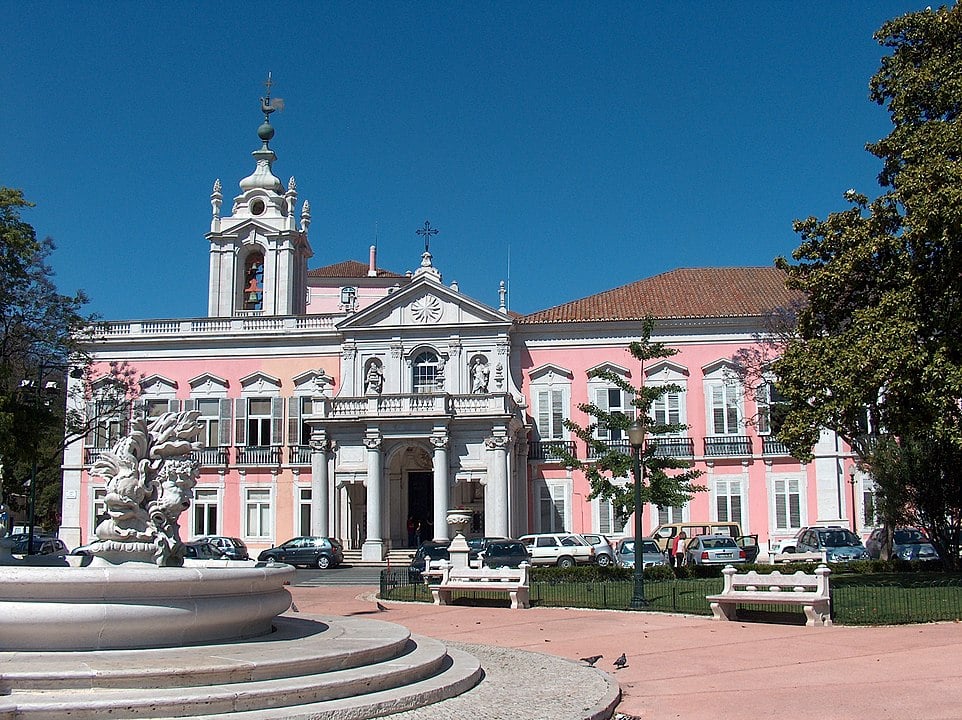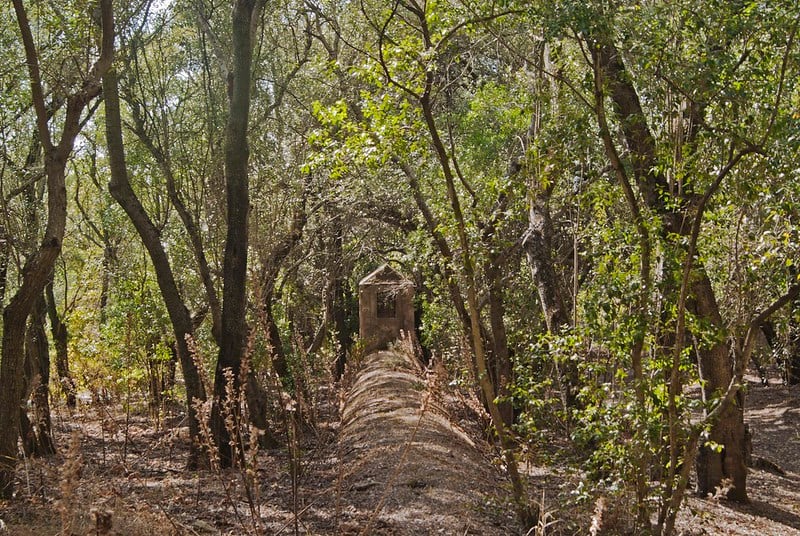On the Western side of Lisbon, just below Campo de Ourique, stands a palace with incredible views and its gardens hidden behind high walls. This magnificent ten-hectare garden is truly one of the city’s best and quietest hidden corners and is a great place to get away from it all on a hot summer day.
A Chapel and a Royal Palace
The story of Tapada das Necessidades begins in 1604 with a small chapel dedicated to Our Lady of Needs (Nossa Senhora das Necessidades). According to tradition, the chapel was built by a couple of weavers who had sought refuge from the plague in Ericeira, carrying with them an image of Our Lady of Health that they believed had protected them. Upon their return to Lisbon, they constructed the chapel in gratitude for their survival.
In 1742, King João V acquired the surrounding farmland and commissioned Italian architects to build a grand complex that included a large chapel, a convent for the Congregation of the Oratory of Saint Philip Neri, and a palace for royal residence. The original Baroque design was later transformed in 1841 under King Fernando, who hired the renowned master gardener Jean Bonnard to redesign the gardens in the fashionable English landscape style.
Visit the Site of the Final Chapter of Portuguese Monarchy
Perhaps no location in Portugal witnessed more dramatically the end of an era than the Palácio das Necessidades next to the Tapada. It was here that the final act of the Portuguese monarchy unfolded in October 1910, one of the most significant moments in the nation’s history.

King Manuel II, who had unexpectedly ascended to the throne in 1908 at just 18 years old following the assassination of his father King Carlos I and elder brother Prince Luís Filipe, was residing at the Necessidades Palace when the Republican Revolution erupted. The young king, sometimes known as “Manuel the Unfortunate” or “Manuel the Patriot,” had been struggling to maintain stability in an increasingly divided country.

On the night of October 4, 1910, as republican forces launched their revolt in Lisbon, the Palace of Necessidades came under attack. The cruiser Adamastor, positioned on the Tagus River, began bombarding the palace where King Manuel II was staying. The attack caused significant damage to both the exterior and interior of the palace, with one shell even reaching the king’s private quarters on the first floor. A cracked mirror in the Renaissance Room still remains to this day.
Faced with the overwhelming republican forces and the bombardment of his residence, King Manuel II was forced to flee. He initially took refuge in a small house within the palace’s park before ultimately escaping to the Mafra National Palace, where he rendezvoused with his mother, Queen Amélia, and grandmother, Queen Mother Maria Pia of Savoy. The following day, on October 5, 1910, the royal family boarded the yacht Amélia IV and sailed into exile, first to Gibraltar and then to England, where Manuel would spend the rest of his life. Portugal’s monarchy had ended, and the young king would never return to his homeland.
What Visitors Can Enjoy Today
Today, the Tapada das Necessidades, the park retains much of its romantic, slightly wild character and offers a unique experience that feels a world away from the center of Lisbon.
The park’s three small lakes called Palmeira, Estrelícias, and Duque de Lafões, which are surrounded by exotic vegetation and home to waterfowl including ducks, geese, and the famous peacocks that roam freely throughout the grounds. One of the most photographed features is the historic circular greenhouse, a glass dome structure built with forged iron. The park also boasts what is believed to be one of the oldest cactus gardens in Europe and features an impressive collection of cacti and succulents that adds an unexpected botanical element to the landscape.

The English-style landscaping, with its tree-lined paths, manicured lawns, and carefully curated flora, creates a wonderfully calm atmosphere that’s perfect for picnics, reading, or simply relaxing away from the hustle and bustle of central Lisbon. Among the older structures that still remain on the property, visitors can discover the Casa de Fresco, an elegant building with frescoes that reflect the opulence of the royal era, and the Casa do Regalo, which served as Queen Amélia’s painting studio after its construction in 1889. Scattered throughout the grounds are various pieces of statuary, including the notable “Virtudes” series, along with the remains of a small zoo that was built specifically for the royal family’s enjoyment.
The park has become a beloved spot for visitors, attracting families with children, couples looking for romantic walks, photographers drawn to its photogenic peacocks and architecture, and anyone looking for a peaceful escape from city life.

Pálacio das Necessidades – A Government Building Today
While visitors can freely explore the gardens, it’s important to note that the Pálacio das Necessidades itself is not open to the public. Since approximately 1950, this striking pink palace has served as the headquarters of the Portuguese Ministry of Foreign Affairs. The building now conducts the country’s diplomatic affairs.
Most of the original royal collections, including art, furnishings, and other artifacts, were transferred to the museum at the Palace of Ajuda to ensure their preservation for future generations.
Before you enter the gardens adjacent to the Pálacio das Necessidades, don’t miss the stunning view of the Ponte 25 de Abril. It is truly spectacular!
Planning Your Visit
The Tapada das Necessidades is open every day from 8:00 AM to 8:00 PM. Entry to the park is free.
Finding the entrance to Tapada das Necessidades can be part of the adventure. The park has two main access points: the north entrance on Rua do Borja near the corner with Calçada das Necessidades, and the south entrance at Largo das Necessidades where there’s usually a guard present.
Many visitors recommend entering through the north entrance on Rua do Borja, where you’ll find what appears to be a modest doorway in an imposing wall. This entrance provides a more dramatic reveal of the park’s beauty and allows for a pleasant downhill stroll through the grounds. It makes it feel like you’re discovering a secret garden hidden within the city.
The park is easily accessible by public transportation, with bus route 773 stopping nearby and tram 28’s final stop at Cemitério dos Prazeres just a short walk away. Those staying in the Estrela district or near Alcântara-Terra train station can comfortably walk to the park.
Visitors should be aware that bathroom facilities in Tapada das Necessidades are limited and somewhat inconsistent. It is advisable to use the restroom before entering the park or be prepared that options may be basic or potentially unavailable depending on maintenance schedules.
When planning your visit, consider bringing a picnic lunch to enjoy on the extensive grassy areas, a camera for capturing the peacocks and historic buildings, and comfortable walking shoes for exploring the tree-lined paths. During warmer months, bringing water is especially recommended, and book lovers will find plenty of quiet spots perfect for reading under the shade of ancient trees.


